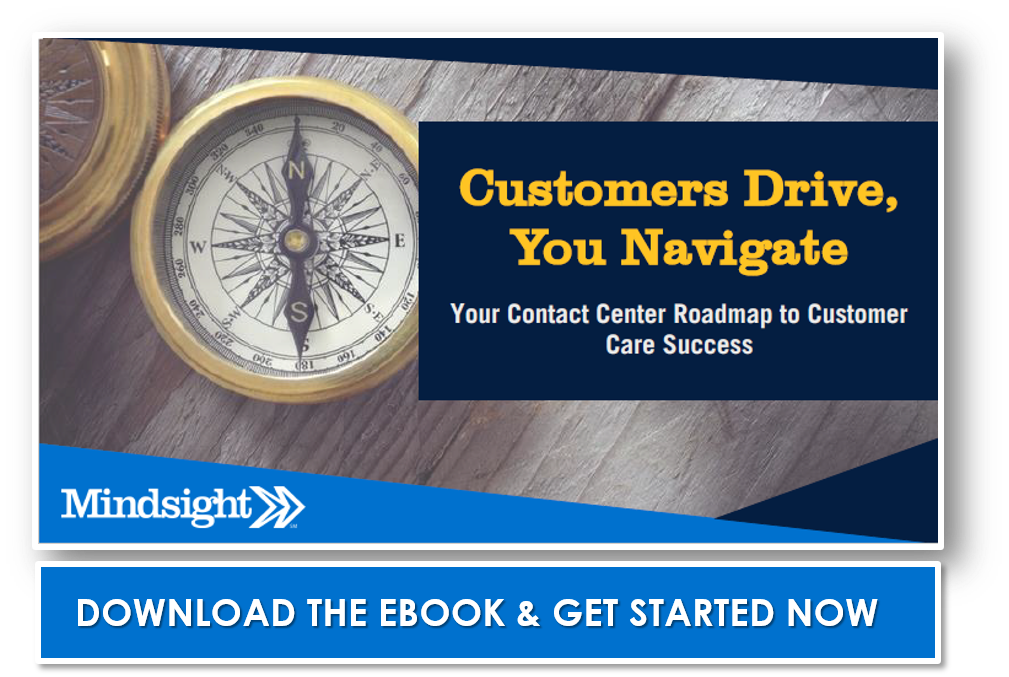January 3, 2019 by Siobhan Climer
Determining the value of technology investments in any industry is essential – and essentially difficult. A return-on-investment (ROI) offers a familiar, albeit flawed, method for calculating the financial benefit of digital transformations and business agility.
Contact centers are no strangers to quantifying value; whether it’s measuring first-call resolutions, forecasting accuracy, or customer satisfaction, call centers are constantly fine-tuning the analytics that deliver on the customer experience. Learning how to calculate contact center ROI is one way the often-disparate worlds of technology and business can connect, communicate, and contextualize the value of everything from contact center platforms to artificial intelligence.
Planning a contact center technology deployment? It’s important to ensure that when you add a new technology, it fits into the long-term roadmap for the business. Read Customers Drive, You Navigate: Your Contact Center Roadmap To Customer Care Success to learn more.
What Exactly Is ROI
Back to school! Let’s revisit some basics first. An ROI provides one simple view into the value of any business investment. The basics are just that – basic – which is why it is such a popular way of examining business decisions.
ROI (%) = Return of Investment/Cost of Investment
 Anything that simple should not be trusted lightly. Many issues exist with relying solely on ROI to make business decisions. False assumptions are rampant. Intangible or “soft” costs or benefits are often excluded. Determining precisely which costs or benefits should be attributed to the investment is challenging. Even identifying the precise time-period with which to measure ROI can be controversial (especially with technology!).
Anything that simple should not be trusted lightly. Many issues exist with relying solely on ROI to make business decisions. False assumptions are rampant. Intangible or “soft” costs or benefits are often excluded. Determining precisely which costs or benefits should be attributed to the investment is challenging. Even identifying the precise time-period with which to measure ROI can be controversial (especially with technology!).
It is important that when presenting an ROI to decision-makers these considerations are clearly identified so exaggerated benefits – or costs – do not become embedded in the conversation.
Despite these concerns, working to calculate contact center ROI is valuable for business leaders considering whether investing in a contact center technology is worthwhile.
Calculate Contact Center ROI
Fortunately, when it comes to technology, the costs and benefits are easily accessible. This makes the process by which you calculate contact center ROI relatively straightforward.
Typical Investment Costs – Calculate Contact Center ROI
Subscription/License Costs – Includes cost of monthly/annual subscription per user. Be sure to account for seasonal adjustments or temporary staffing.
IT Labor and Support Costs – Includes uptime, maintenance, configurations, patching, support, accounts, and other IT needs. This is one of the few flexible areas, as many IT teams use team extensions via managed services providers.
Implementation Costs – Deployment and infrastructure investments are important, too. Include any additional service or hardware purchases needed to deploy the technology.
Typical Investment Benefits – Calculate Contact Center ROI
Cost reduction – These returns are seen in the form of decreased downtime, increased agent responsiveness, improved forecasting and analytics, and/or decreased IT labor needs.
Employee retention – Better tech often leads to improved performance and employee satisfaction. Account for any changes in employee satisfaction (recommend gathering data several times over a longer period, such as 4x/year for next 2 years).
Better productivity – Consolidated systems, reduced agent handle time, improved collaboration, and improved management are some of the anticipated benefits of a contact center solution.
Increased income – Facilitating the handling of higher volumes or improving the customer experience are important to account for during your ROI analysis.
Managed Services Solves the 3 IT Challenges for the Contact Center
Do The Math And Calculate Contact Center ROI
Add up the various costs and benefits and use the equation below to calculate a percentage or ratio that represents a quantifiable ROI.
ROI (%) = Return of Investment/Cost of Investment
Adding a contact center technology, like a custom-built IVR or a Genesys or Cisco platform, offers many benefits to the business, but understanding those benefits in the context of investment is an important consideration. This is especially true if IT and technology are considered secondary elements to business objectives. Demonstrate to the leadership team how technology offers returns again and again by working to calculate contact center ROI.
Like what you read?
Contact us today to discuss a contact center solution.
About Mindsight
Mindsight, a Chicago IT services provider, is an extension of your team. Our culture is built on transparency and trust, and our team is made up of extraordinary people – the kinds of people you would hire. We have one of the largest expert-level engineering teams delivering the full spectrum of IT services and solutions, from cloud to infrastructure, collaboration to contact center. Our highly-certified engineers and process-oriented excellence have certainly been key to our success. But what really sets us apart is our straightforward and honest approach to every conversation, whether it is for an emerging business or global enterprise. Our customers rely on our thought leadership, responsiveness, and dedication to solving their toughest technology challenges.
Contact us at GoMindsight.com.
About The Author
Siobhan Climer, Science and Technology Writer for Mindsight, writes about technology trends in education, healthcare, and business. She previously taught STEM programs in elementary classrooms and museums, and writes extensively about cybersecurity, disaster recovery, cloud services, backups, data storage, network infrastructure, and the contact center. When she’s not writing tech, she’s writing fantasy, gardening, and exploring the world with her twin two-year old daughters. Find her on twitter @techtalksio.

